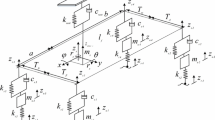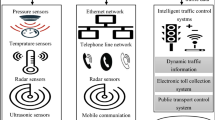Abstract
As a newly proposed two terminals mechanical element, inerter has been successfully applied in vehicle suspension system to improve its vertical vibration isolation performance. The novelty of this paper is to explore the advantages of lateral stability of vehicle suspension by the use of inerter element. A full car model considering the steering condition is built, and the standard fishhook steering input is chosen to test the lateral stability of the suspension system. By considering the ride comfort performance and the rollover resistance performance, three basic suspension layouts incorporating inerter element are optimized by means of genetic algorithm. Constraints of the suspension working space and road holding ability are also taken into account during the optimization. Two steering input condition, namely the sine-steer input and the fishhook steer input are performed to evaluate the vehicle suspension performance. Results show that, the ride comfort and the lateral stability of the vehicle suspension system can be synchronously improved by including the inerter element.
Similar content being viewed by others
References
National Center for Statistics and Analysis. NHTSA 2004 annual assessment, Motor Vehicle Traffic Crash. Fatality Counts and Injury Estimates for 2004. Report NHTSA DOT HS 809923. Washington. US Department Of Transportation, National High-way Traffic Safety Administration. 2004
Parida N C, Raha S, Ramani A. Rollover-preventive force synthesis at active suspensions in a vehicle performing a severe maneuver with wheels lifted off. IEEE Trans Intell Transp Syst, 2014, 15: 2583–2594
van der Westhuizen S F, Els P S. Slow active suspension control for rollover prevention. J Terra Mech, 2013, 50: 29–36
Han I, Rho K. Characteristic analysis of vehicle rollover accidents: Rollover scenarios and prediction/warning. Int J Automot Tech, 2017, 18: 451–461
Zhu B, Piao Q, Zhao J, et al. Integrated chassis control for vehicle rollover prevention with neural network time-to-rollover warning metrics. Adv Mech Eng, 2016, 8: 11–13
Akar M, Dere A D. A switching rollover controller coupled with closed-loop adaptive vehicle parameter identification. IEEE Trans Intell Transp Syst, 2014, 15: 1579–1585
Smith M C. Synthesis of mechanical networks: The inerter. IEEE Trans Automat Contr, 2002, 47: 1648–1662
Chen M Z Q, Smith M C. Restricted complexity network realizations for passive mechanical control. IEEE Trans Automat Contr, 2009, 54: 2290–2301
Jiang J Z, Smith M C. Regular positive-real functions and five-element network synthesis for electrical and mechanical networks. IEEE Trans Automat Contr, 2011, 56: 1275–1290
Chen M Z Q, Wang K, Zou Y, et al. Realization of a special class of admittances with one damper and one inerter for mechanical control. IEEE Trans Automat Contr, 2013, 58: 1841–1846
Zhang S Y, Jiang J Z, Neild S. Optimal configurations for a linear vibration suppression device in a multi-storey building. Struct Control Health Monit, 2017, 24: e1887
Li Y, Jiang J Z, Neild S. Inerter-based configurations for main-landing-gear shimmy suppression. J Aircraft, 2016, 54: 684–693
Lazar I F, Neild S A, Wagg D J. Using an inerter-based device for structural vibration suppression. Earthq Engng Struct Dyn, 2014, 43: 1129–1147
Wang F C, Wu S Y. Vibration control of an optical table employing mechatronic inerter networks. J Vib Control, 2016, 22: 224–234
Wang F C, Liao M K. The lateral stability of train suspension systems employing inerters. Vehicle Syst Dyn, 2010, 48: 619–643
Smith M C, Wang F C. Performance benefits in passive vehicle suspensions employing inerters. Vehicle Syst Dyn, 2004, 42: 235–257
Hu Y, Chen M Z Q, Shu Z. Passive vehicle suspensions employing inerters with multiple performance requirements. J Sound Vib, 2014, 333: 2212–2225
Shen Y, Chen L, Yang X, et al. Improved design of dynamic vibration absorber by using the inerter and its application in vehicle suspension. J Sound Vib, 2016, 361: 148–158
Soong M F, Ramli R, Mahadi W N L, et al. Ride improvement of vehicle suspensions with switchable inerter based on force cancellation strategy. J Vibroengineering, 2017, 19: 1260–1272
Zhang X J, Ahmadian M, Guo K H. On the benefits of semi-active suspensions with inerters. Shock Vib, 2012, 19: 257–272
Seifi A, Hassannejad R, Hamed M A. Optimum design for passive suspension system of a vehicle to prevent rollover and improve ride comfort under random road excitations. P I Mech Eng K, 2016, 230: 426–441
Author information
Authors and Affiliations
Corresponding author
Rights and permissions
About this article
Cite this article
Shen, Y., Chen, L., Liu, Y. et al. Improvement of the lateral stability of vehicle suspension incorporating inerter. Sci. China Technol. Sci. 61, 1244–1252 (2018). https://doi.org/10.1007/s11431-017-9228-0
Received:
Accepted:
Published:
Issue Date:
DOI: https://doi.org/10.1007/s11431-017-9228-0




